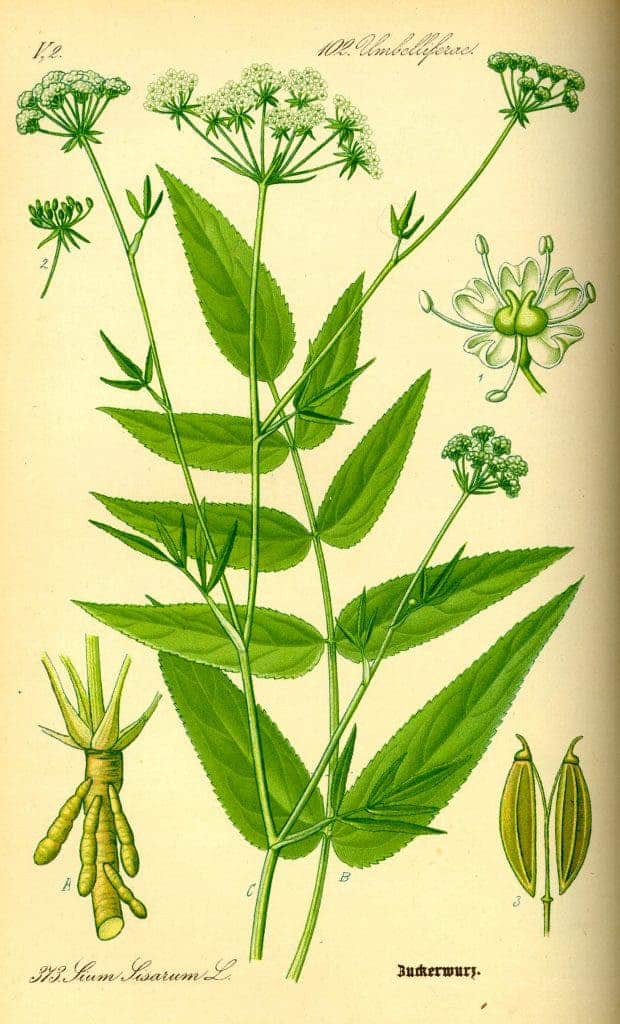Ignored for centuries, this vegetable might be slowly making a comeback in England.
‘The sweetest, whitest and most pleasant of roots,’ wrote gentleman gardener John Worlidge in his 1677 Systema Horticulturae. A staple of Tudor foods and a preferred vegetable of the Roman Emperor Tiberius, skirret is all but forgotten by the modern world.
The plant is of Chinese origin, but arrived in Europe before Roman times. The plant is actually surprisingly sturdy, growing about 1 meter high and being extremely resistant to cold, pests and diseases. The cooking style is similar to that of carrots. Skirret roots can be stewed, baked, roasted, fried in batter as fritter, or creamed, and also be grated and used raw in salads. The taste is sweeter and it has a more pleasant aroma then carrots, so then why aren’t we using it today?
“It’s just not a commercial crop,” explains Marc Meltonville, food historian at Historic Royal Palaces.
With low yields and fiddly to harvest, poor skirret has been overtaken by the more popular carrots, potatoes and parsnips – better suited for industrial harvests. But not everyone is giving up on it. Vicki Cooke, kitchen garden keeper at Hampton Court in London, has been experimenting with skirret for a year now. It’s not the easiest thing to get hold of, nor is it the easiest thing to grow.
“They are a bit iffy to germinate,” she says, “so it’s best to leave the soil to warm up a little before sowing.”
She grows it as a garden vegetable, so far with good results.
“The old books say it needs a rich soil but I’ve found it to be pretty unfussy,” says Cooke.
The plant thrives in cold or maritime sites, one of the reasons it was popular in Scotland, where it was called a crummock. In order to learn more about it, she had to turn to century-old books from the Tudor period, like Worlidge’s Systema Horticulturae.
“You may also plant them here and there on the edges of your other beds,” the book writes.
Cooke agrees. “I think they’re pretty enough to grow in a flower border. As umbellifers, they look like mini cow parsley with froths of tiny white fragrant flowers to give a fluffy look.”
Will skirret make a large scale return? Unlikely. But more gardeners like Cooke are starting to pay it attention, and it may re-emerge as a niched option.
Skirret vegetables
Here are a few vegetables (mostly medieval) gathered from the Wikipedia Page:
Lentils and Skirrets with Bacon
Put 125 g of bacon, chicken giblets of one chicken, and 8 garlic cloves into a stewing pan with 1 litre of water and cook 30 minutes, skimming often. Strain and reserve the bacon and giblets. Put the stock in a clean stewing pan with 3 cups (750 ml) of water. Add 500 g of green or brown lentils, 3 teaspoons of salt, and half a teaspoon of ground ginger. Chop the giblets and add this to the pot. Chop part of the bacon, enough to yield half a cup (50 g) and add this to the lentil mixture.
Cook 20 minutes over medium heat, then add 1 cup (100g) of sliced skirrets. Continue cooking until the skirrets are tender (about 15 minutes), then add a quarter cup of chopped parsley, half a cup of chopped spring onions, and a quarter cup of dill. Serve immediately in a bowl with the remaining piece of boiled bacon on top.
— Reconstructed from a Medieval recipe from Poland
Fritters of Skirrets, Parsnips and Apples (1460)
Take skirrets, parsnips and apples, and parboil them. Make a batter of flour and eggs. Cast ale, saffron and salt into it. Wet them in the batter and fry them in oil or in grease. Pour on almond milk and serve it forth.
— From John Russell, Boke of Nurture, c. 1460
Skirret Pie (1653)
Take a quarter of a peck of Skerrets blanched, and sliced, season them with three Nutmegs, and an ounce of Cinnamon, and three ounces of Sugar, and ten quartered Dates, and the Marrow of three bones, rouled in yolks of Eggs, and one quarter of a pound of Ringo roots,[8] and preserved Lettice, a sliced Lemon, four blades of Mace, three or four branches of preserved Barberries, and a half a pound of Butter, then let it stand one hour in the oven, then put a caudle made of white Wine, Verjuyce, Butter, and Sugar, put into the pye when it comes out of the oven.











